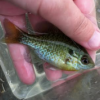Our neighbors have a pool that's been sitting empty for a couple of years and is now being drained. It's full of second-year bullfrog tads, first-year bullfrog tads, and just-about-to-be-frogs leopard frog tads. I don't want them to die. Can I transfer them to a river? We're half a mile from the river, so I assume the original frogs somehow got up here from there. No animals have ever been added to the pool, the bugs and frogs have just introduced themselves.
If I put these tadpoles in a river, could it transfer pathogens? I'm not sure how frogs in one area could have picked up any pathogens that aren't found half a mile away.
What about if I raised them to frogs and then let them go in a river? I don't think our yard is wet enough to support bullfrogs and leopard frogs, those guys need a lot of water. We barely have enough moisture for toads.
If neither option works, what can I do? I don't have any place to keep 300 frogs. That many tadpoles, maybe, but not that many frogs.











